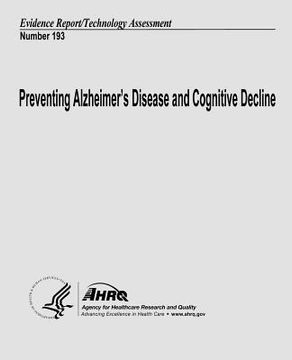Preventing Alzheimer's Disease and Cognitive Decline: Evidence Report/Technology Assessment Number 193 (en Inglés)
Reseña del libro "Preventing Alzheimer's Disease and Cognitive Decline: Evidence Report/Technology Assessment Number 193 (en Inglés)"
Dementia is a loss of cognitive abilities in multiple domains that results in impairment in normal activities of daily living and loss of independence. There are a number of diseases that cause dementia, but the most common is Alzheimer's disease (AD), which is responsible for 60 to 80 percent of all dementia. AD is a neurodegenerative disorder that begins in the mesial temporal lobe causing memory loss, but pathology soon spreads into other brain regions causing dementia. The major risk factor for AD is age, with the prevalence doubling every 5 years after the age of 65. The worldwide prevalence of dementia is estimated to be 35.6 million in 2010, with the number exceeding 65 million in 2030 and 115 million in 2050, making it a pressing global health concern. The diagnosis of AD is challenging both clinically and pathologically. There are multiple sets of well-established criteria for the clinical diagnosis of AD. There is some variation among the sets of criteria, but each requires evidence of cognitive and functional decline that impacts the individual's ability to carry out routine daily activities. Even though significant progress has been made in identifying imaging, cerebrospinal fluid, and blood markers of disease, the diagnosis of AD during life currently is based primarily on the phenotypic presentation of cognitive and functional decline. The term cognitive decline covers a continuum of cognitive changes, some of which are considered to be within the spectrum of normal aging and others that exceed expected decline for normal aging and are categorized as mild impairment. Typically performance in one or more cognitive domains such as memory, orientation, language, executive function, and praxis are assessed to determine decline. The diagnostic threshold between normal and pathological cognitive changes is imprecise. Pathological cognitive decline is often referred to as mild cognitive impairment (MCI) or cognitive impairment not demented (CIND); each term has multiple subtypes reflecting the construct of multiple etiologies. The diagnostic criteria for MCI and CIND are still evolving, but guidelines generally include greater than expected cognitive decline for the individual's age and education level, and no more than mild functional impairment insufficient to meet the threshold for a diagnosis of dementia. The number of individuals with MCI or CIND exceeds that of AD. The prevalence of CIND in 2002 was estimated to be 5.33 million individuals over age 70 (22 percent), based on a nationally representative sample. These individuals are at increased risk for development of AD, which makes them a prime target for intervention protocols. AD has a wide-ranging impact on individuals, families, and healthcare systems. The aim of this review is to summarize the available literature, frame the discussion regarding potential risk factors, and highlight the limitations of the evidence base. We synthesized the existing literature on the following key questions: KQ1: What factors are associated with the reduction of risk of Alzheimer's disease? KQ2: What factors are associated with the reduction of risk of cognitive decline in older adults? KQ3: What are the therapeutic and adverse effects of interventions to delay the onset of Alzheimer's disease? Are there differences in outcomes among identifiable subgroups? KQ4: What are the therapeutic and adverse effects of interventions to improve or maintain cognitive ability or function? Are there differences in outcomes among identifiable subgroups? KQ5: What are the relationships between the factors that affect Alzheimer's disease and the factors that affect cognitive decline? KQ6: If recommendations for interventions cannot be made currently, what studies need to be done that could provide the quality and strength of evidence necessary to make such recommendations to individuals?

